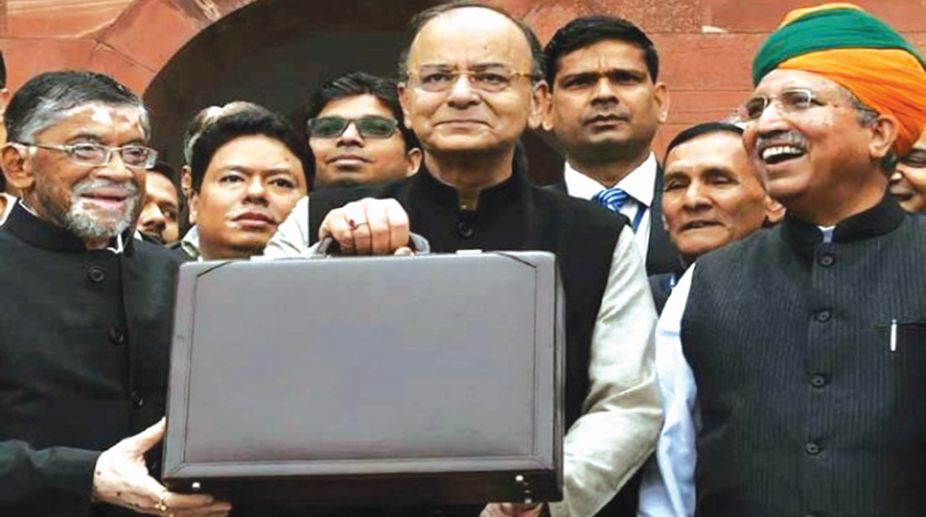Conscription law
In the crucible of conflict, Ukraine finds itself at a critical juncture, grappling with the harsh reality of war's relentless toll.

FM Arun Jaitley
This year the union budget presentation departed from the usual practice in one important respect. Generally, the budget speech mentions expenditure estimates of important development programmes and schemes. Often the extent to which these estimates have increased compared to the previous year is also mentioned. Hence the extent to which allocations for the most important programmes have changed becomes an area for discussion.
This time this did not happen with important programmes and development sectors. On the other hand, some new schemes and initiatives were announced but it was not clear where the funds for these important initiatives would come. After widespread questions, the government a day later announced a sort of a road map for its most important announcements on health and insurance care. But even this cannot be considered an adequate explanation in view of the magnitude of the scheme announced.
What is more, this year the overall resource situation at the time of presentation of the budget was more uncertain than in the past. Statistics are available only up to November 2017. These indicate that overall revenue receipts at this time were only 53 per cent of Budget Estimate for the financial year and this was despite the fact that a lot of GST refunds have become due.
Advertisement
The revenue receipts at the same point of time in the previous year were 58 per cent. Only ‘other receipts’, consisting mainly of disinvestment, were much higher compared to the previous year (42 per cent compared to 72 per cent) but frankly this is one source of earning the government should not be proud of.
At the end of November in the previous financial year, 86 per cent of the fiscal deficit for the entire financial year had been reached but this year 112 per cent of the fiscal deficit for the year had been reached by November end (Rs. 612105 crore compared to the earlier year-end estimate of Rs. 546532 crore). The resource uncertainty has become high particularly due to GST related factors. Tax revenue (net) from Integrated Goods and Services Tax was Rs. 70,918 crore in August, Rs 30,395 crore in September, Rs 18,370 crore in October and Rs 18,627 crore in November.
Keeping in view this uncertain resource position, people were surprised when the budget speech announced ‘the world’s largest government health care programme’ in the form of a National Health Protection Scheme to cover 10 crore poor and vulnerable households (or nearly 50 crore people) to provide coverage of up to Rs 5 lakh per family per year. While people were overwhelmed by the sheer magnitude of the scheme, the speech did not mention the estimated budget for this. As the overall allocation for health and social protection had not increased significantly there was uncertainty about how this programme would be financed.
One day later, some sort of an explanation emerged in the form of expenditure of around Rs. 12,000 crore, Centre-state sharing of expenses and launch date of October 2 or so. But in fact, a lot of planning and preparation, human resource and financial mobilisation, talks with state governments etc. are needed in a spirit of transparency and public participation. But this was not visible in the context of such an important initiative.
This is just one example of how expenditure on a big initiative has not been explained in the Budget. Farmers have been told that their long pending demand for a significant increase in support price is at last being met. This obviously calls for a big increase in food subsidy, or in the allocation for the Ministry of Agriculture. However, the increase in allocation cannot be found in either of these allocations (budget estimates).
Similarly, in the case of the expenditure on livelihoods and infrastructure in rural areas, the bulk is said to be from non-budgetary or extra-budgetary resources. But it is not clear what these extra resources are and to what extent we can be sure of their availability.
There have been several changes in budget presentation in recent years such as the merging of plan and non-plan expenditures due to which comparisons with earlier trends becomes difficult. This is particularly true of sub-plans for scheduled castes and tribes.
Several aspects have been taken out of the Budget as it is approved by the Parliament. There have substantial downward revisions of expenditure estimates for important programmes. When added to the lack of correlation between announced schemes and budgetary allocations seen in this Budget, it suggests a decrease in transparency.
One hopes that such trends are checked before it is too late. There is certainly need for greater public awareness of the budget, and of revenue and expenditure related issues in a democracy.
The writer is a freelance journalist who has been involved with several social movements and initiatives.
Advertisement